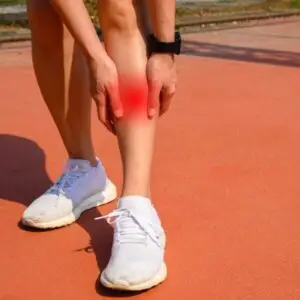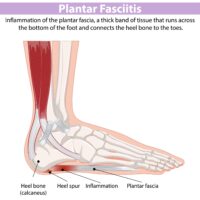Feeling a bit betrayed by your legs lately? If your shins have been aching and complaining after your workouts, you might be dealing with shin splints, medically known as medial tibial stress syndrome (MTSS). Before you consider swapping your trainers for a comfy pair of slippers, know that there’s help at hand! Give Completely Aligned a call at 02 4655 5588 to book an appointment with one of our osteopaths and get back on your feet—literally.
Shin splints: Not just a pain in the shin
Shin splints are that nagging pain you feel along the inner edge of your shinbone, the tibia. It’s the result of overworked muscles, tendons, and bone tissue, often from pushing your body a bit too hard or a bit too fast. They tend to strike with a sudden increase in activity levels. This condition is like your body’s way of saying, “Whoa, slow down there!” And while it’s common among runners, dancers, and the fitness enthusiasts of the world, even the most casual walkers can find themselves sidelined by shin splints.
The anatomy behind shin splints
Let’s take a quick tour of your shins. The tibia, or shinbone, is the star of the show, bearing the brunt of your body weight during activities like walking, running, or even that mad dash for the bus. Running alongside the tibia is the tibialis posterior muscle, a key player in keeping your foot arch in check and your ankle steady.
When you overdo it, this muscle can pull on the periosteum (the thin layer of tissue hugging your bone), leading to that familiar, unwelcome pain. But it’s not just the tibialis posterior that’s working overtime—the soleus, deep within your calf, and the flexor digitorum longus, which flexes your toes, are also in the mix. When these muscles get tired, they tug on their tendons and the surrounding tissues, causing microtrauma and inflammation. In short, your shins are screaming for a break.
What causes shin splints?
Shin splints can sneak up on you for several reasons, including:
- Too much too soon: Whether you’ve ramped up your running routine or suddenly decided to take up tap dancing, increasing your activity level too quickly can push your lower legs past their limits. As with all things a steady increase is the best way to see sustainable improvement!
- Poor footwear choices: Those old, worn-out trainers might be doing you more harm than good. Without the right support, your biomechanics go out the window, leading to shin pain.
- Flat feet or over-pronation: If your feet have the tendency to flatten or roll inward, the extra strain on your tibia can lead to shin splints.
- Hard surfaces: Running on hard or uneven surfaces doesn’t just make your workout more challenging; it also puts extra stress on your shins.
Home care: What to do (and what to avoid)
If shin splints have you down, don’t worry—there are a few things you can do at home to ease the pain:
- Rest: Your body needs time to recover, so it’s okay to hit pause on your workout routine for a while.
- Ice, ice baby: Applying ice to your shins for 15-20 minutes a few times a day can help reduce inflammation and numb the pain.
- Compression: A compression bandage can help keep swelling in check.
- Elevation: Keeping your legs elevated can also help reduce swelling.
- Stretching and strengthening: Incorporating gentle stretching into your routine can help relieve tight muscles. Focus on stretches that target the soleus, tibialis posterior, and flexor digitorum longus—key muscles involved in shin splints. For example:
- Soleus stretch: Perform a bent-knee calf stretch by standing in front of a wall
- with one foot behind the other. Bend both knees, keeping your back heel on the ground, and lean into the stretch. This targets the lower part of your calf, where the soleus muscle resides.
- Tibialis posterior stretch: Sit on the floor with your legs extended. Use a towel or resistance band around the ball of your foot and gently pull your toes towards your shin, focusing on the inner lower leg. This helps relieve tension in the tibialis posterior.
- Flexor digitorum longus stretch: Stand and pull your toes upwards towards your shin, either by hand or with a towel. This stretch targets the bottom of your foot and the back of your lower leg.
How osteopathy can get you back on track
When it comes to shin splints, osteopathy can be a game-changer. Here’s how we work to get you back on your feet—without the pain:
- Biomechanical assessment: An osteopath will take a close look at how you move, from your foot posture to your gait. We’ll assess the alignment of your pelvis, hips, knees, and ankles to pinpoint any underlying issues contributing to your shin splints.
- Joint mobilisation: By gently mobilising the joints in your ankles, knees, and hips, we can help improve their function and range of motion. This takes the strain off your tibia and the surrounding muscles.
- Soft tissue work: Using techniques like massage, we’ll work on releasing tension in the muscles and fascia around your shin. This not only feels great but also boosts circulation to speed up healing.
- Trigger point therapy: Those pesky trigger points in your calf muscles, especially in the soleus and tibialis posterior, might be part of the problem. We’ll target them to reduce pain and release muscle tension.
- Personalised exercises: We won’t just treat your shin splints; we’ll help prevent them from coming back. Your osteopath will prescribe exercises to strengthen your lower leg muscles and improve your overall biomechanics. Think calf stretches, foot arch strengthening, and balance drills—all tailored to you.
Shin splints might be a pain, but they don’t have to keep you down for long. Ready to step back into your routine without the ache? Call 02 4655 5588 today to book an appointment at Completely Aligned, or book online now. And don’t forget to follow us on social media for more tips and advice to keep you moving! We’re on Instagram and Facebook.
We're ready when you are
Don't let pain hold you back from doing the things you love
At Completely Aligned, our door is always open for you to get back to doing the things you love in life. Our team are available now to chat with you and work out how we can best support you.







